Preprint
Article
Comparative Study on the Properties of Nitrile Rubber Filled with Carbon Powder and Carbon Black
Altmetrics
Downloads
41
Views
23
Comments
0
This version is not peer-reviewed
Submitted:
27 September 2024
Posted:
29 September 2024
You are already at the latest version
Alerts
Abstract
The properties of carbon powder filled nitrile rubber (NBR) were investigated. The effect of carbon powder content on the mechanical strength, vulcanization properties, mechanical properties, electrical conductivity, and thermal conductivity of NBR was explored. The purpose of the research is to pursue the optimal filling ratio and conditions of carbon powder to optimize the performance of rubber products.The reasonable filling range of carbon powder has been compared with N660 carbon black filled NBR and determined to evaluate the advantages and disadvantages of carbon powder. The suitable application scenarios of carbon powder is clarified .The research results indicate that carbon powder can delay the sulfurization of NBR in the sulfurization system. The research results indicate that carbon powder can delay the sulfurization of NBR. In terms of filling system, the tensile strength, tear strength, and elongation at break of NBR gradually enhance as the amount of carbon powder increases. Carbon powder can replace carbon black in the application of NBR to improve the comprehensive performance of NBR, which provides a new kind of reinforcing material for NBR.
Keywords:
Subject: Chemistry and Materials Science - Materials Science and Technology
1. Introduction
NBR is a polymer elastomer made by polymerizing butadi-ene and acrylonitrile. As an important synthetic rubber, it has been widely used in various products such as rubber hoses, gas-kets, etc [1].
As NBR is a non-crystalline rubber, its internal molecular structure is irregular and lacks self reinforcing properties, and needs to be reinforced before it has practical value [2].
Extensive and in-depth research has been conducted in the scientific and engineering communities on reinforcement mate-rials for NBR rubber.
He Shaojian, etc [3] studied studied the effect of anhydrous copper sulfate vulcanization on enhancing NBR. You Haijun, etc [4] studied the effect of carbon black species on the physical and mechanical properties, dynamic mechanical properties and heat resistance of NBR. Salaeh S, Nakason C, etc [5] studied the ef-fect of modified NR and carbon black structure on the properties of NR compounds. Bhadran B, Vijayan D, George N, etc [6] studied the reinforcing effect of organic clay in NBR. Chen Zilong, etc [7] investigated the effect of MT on the properties of NBR.
Carbon black is a typical carbon nanofiller with a large spe-cific surface area and a large number of surface active groups, which can generate strong interactions with NBR. It is most commonly used as the various types of filling material to en-hance the rubber properties [8]. It is generally made from fossil re-sources such as oil and natural gas. In order to develop more cost-effective reinforcing materials, domestic and foreign scien-tists have carried out a lot of research [9]. Carbon powder is a new type of black carbon material, its particle size is about 200nm to 1µm as shown in Figure 1. Its composition is the same as carbon black and can also be used as the rubber reinforcement material.
Under the SEM magnification of 30000x, the particle size distribution of carbon powder can be observed more intuitively and clearly. As shown in Figure 3. Carbon powder is composed of uniformly sized sheet-like carbon materials, ranging in size from nanometers to micrometers, and has a good dispersion effect in rubber. As shown in Figure 4. N660 carbon black is a nanoscale material composed of carbon particles of uniform size [10].
Compared with other reinforced materials, such as carbon black N660, carbon powder has the advantages of low cost, high thermal stability and environmental friendliness.
In this work, carbon powder was used to reinforce NBR, and the effect of the carbon powder filling amount on the curing properties, mechanical properties, and electrical and thermal conductivity of NBR was investigated, and the corresponding properties of NBR were compared with those of N660 carbon black. The research results is conducive to deepening the under-standing of carbon powder properties and further grasping the effect of carbon powder on NBR properties. It provides the new type of reinforced materials for the development of rubber for-mulas.
2. Experiment
2.1. Raw Materials and Formula
Experimental raw materials and formula (mass fraction) were: NBR 100, zinc oxide ZnO 5, stearate acid SA1, 2-merhydrylbenzimidazole MB1.5, accelerator CZ 1.5, rubber ac-celerator TMTD 0.2, carbon powder variable, N660 carbon black variable, sulfur 1.8. The formula variables are listed in Tab.1. The 100phr NBR is filled with 20phr, 30phr, 40phr and 50phr carbon powder respectively. Two groups of components were compared: (1)100phr NBR was filled with 20phr, 30phr, 40phr and 50phr N660 carbon black. (2) 100phr NBR was filled with the mixture of 10phr carbon powder and 10phr carbon black, the mixture of 20phr carbon powder and 20phr carbon black.
Table 1.
Formula variable.
| component | Dosage / portion | |||||||||
|---|---|---|---|---|---|---|---|---|---|---|
| 1# | 2# | 3# | 4# | 5# | 6# | 7# | 8# | 9# | 10# | |
| carbon powder | 0 | 0 | 0 | 0 | 20 | 30 | 40 | 50 | 10 | 20 |
| N660 carbon black | 20 | 30 | 40 | 50 | 0 | 0 | 0 | 0 | 10 | 20 |
2.2. Instruments and Equipment
Double Roller Mixer, BL-6175-BL.Pneumatic Automatic Mi-crotome, GT-7016-AR.No Rotor Vulcanizer, MDR2000. Rubber Vulcanizing Machine, HS-100T-2. Tensile testing machine, GT-AI-7000M. Shaw Rubber Hardness Tester, LX-A. Direct Spe-cific Gravity Reading Scale, XB-220A. Thermal conductivity me-ter, LFA447. Broadband Dielectric Impedance Spectrometer, ZGS-170808T-722. SEM, JSM-7500F.
2.3. Experimental Scheme
The influence of the filling amount of carbon powder on the vulcanization properties, mechanical properties, electrical con-ductivity and thermal conductivity of NBR was investigated. The hardness, tensile strength, elongation at break, permanent set at tear, rectangular tear strength, electrical conductivity and thermal conductivity were analyzed. The specific experimental process is as follows:
Clean the roll and plasticize the weighed NBR on the two-roller machine before mixing. Wrap the roller about 10 times until the surface of the rubber is smooth.
First add ZnO, SA, MB, CZ and TMTD, which are not signif-icantly affected by temperature. After mixing evenly, add rein-forcement materials. Finally, add sulfur on the open mill and mix evenly. Adjust the roller gap to 2-3mm, roll the rubber into a tri-angular package 7-8 times, and then cut the rubber sheet
After parking for 24 hours, measure the rheological curve of the mixed rubber on a rotorless vulcanizing instrument to deter-mine the positive vulcanization time.
Sulfurization is carried out on a flat vulcanizing machine, with the conditions set at 160 ℃ × (t90+2min) and a vulcaniza-tion pressure of 10MPa. The mixed rubber is vulcanized into a standard sample.
Finally, the sulfurization characteristics, mechanical prop-erties, electrical conductivity, and thermal conductivity of the prepared NBR composite materials were tested.
2.4. Performance Testing
(1) SEM analysis: Observe the microscopic morphology of the carbon powder and the section of the rubber composite mate-rial, spray the carbon powder with gold before observation, and put the rubber composite material in liquid nitrogen for brittle fracture and other treatment.
(2) Vulcanization performance test: The vulcanization curve and various characteristic parameters of the mixed rubber was tested according to GB/T9869-1997 standard.
(3) Mechanical properties test: The tensile properties of the vulcanizing adhesive was tested according to GB/T528-2009 at the stretching speed of 500 ± 50 mm/min. The tear strength was tested according to GB/T529-2008, the Shore A hardness was tested according to GB/T531-1999 . Each of the above testing items should be tested at least 5 times.And the average value should be taken as the result..
(4) Conductivity test: A resistance meter was used to test the resistivity according to the GB/T5729-2017 standard.
(5) Thermal conductivity test: Thermal conductivity was tested according to GB/T10295.
3. Results and Analysis
3.1. Raman Spectra of Carbon Powder and N660 Carbon Black
The Raman spectra of carbon powder and N660 carbon black are shown in Figure 5 and Figure 6. It can be seen that the intensi-ty of the D peak of carbon powder is relatively strong, while that of the G peak is relatively weak. The strength of the G peak of N660 carbon black is higher, while the strength of the D peak is lower, so the carbon powder is a carbon material with slight de-fects or impurities compared to N660 carbon black.According to the size of ID/IG, the ID/IG of carbon powder >1 and the ID/IG of N660 carbon black<1, it can be considered that the degree of graphitization of carbon powder is lower than that of N660 car-bon black, and the degree of graphitization of carbon powder is slightly worse.
3.2. SEM of the NBR Composite Material Cross Section
After low-temperature brittle fracture treatment of NBR composite material, its cross-section was scanned by SEM to ob-serve the dispersion of carbon powder particles in the rubber ma-trix. The SEM image with 5000x NBR amplification for the addi-tion of 20phr carbon powder is shown in Figure 7. From the picture, it can be seen that the carbon powder particles have a good dis-persion effect and no agglomeration phenomenon occurs.
The SEM image of NBR with 40phr carbon powder added and magnified 5000x is shown in Figure 8. It is found that the car-bon powder particles can be uniformly dispersed in the rubber matrix when 40phr is added, and there are occasional agglomer-ations at the beginning, Due to the agglomeration of carbon powder particles inside the rubber matrix, secondary aggregates are formed, which destroys the original internal network struc-ture and weakens the reinforcement effect [11].
The SEM image of NBR with 20phr and 40phr N660 carbon black respectively added and magnified 5000x is shown in Figure 9 and Figure 10. Comparing with the cross section SEM of carbon powder filled NBR, it can be seen that the dispersion of carbon powder in NBR is not much different from that of N660 carbon black, and the same agglomeration phenomenon occurs at the addition of 40phr, only that the dispersion particle size of N660 carbon black in NBR is slightly smaller.
The SEM image of NBR mixed with 20phr N660 carbon black/20phr carbon powder added and magnified 5000x is shown in Figure 11. Carbon powder particles and carbon black par-ticles can be uniformly dispersed in the rubber matrix, which is better dispersed than the experimental group filled with carbon powder alone (Figure 8).
3.3. Effect of Carbon Powder on the Sulfuration Properties of NBR
The sulfurization properties of NBR filled with different amounts of carbon powder at 160℃ are listed in Tab. 2. The shear modulus of NBR composite (MH) is related to the vulcan-ized rubber, which mainly depends on the interaction between rubber and filler. After filling with carbon powder, a large num-ber of physical cross-linking points are formed between the car-bon powder and NBR interface, and a large amount of bonding adhesive is formed between the rubber matrix and the carbon powder, which suppresses the flow deformation of the rubber matrix [12].
As the amount of carbon powder added increases, the fluid-ity of the rubber decreases and the modulus of the vulcanized rubber increases. At this time, the carbon powder forms a filler network in the rubber, which has a good interaction with NBR. The maximum torque (MH) and minimum torque (ML) of NBR continue to increase.
Due to the vulcanization of rubber, the network density of the carbon powder combined with the rubber increases, resulting in an increase in the maximum torque and torque difference (MH-ML) [13]. It is generally believed that the difference between the maximum and minimum torque (MH-ML) is proportional to the crosslink density of rubber. As shown in Tab.2, 3 and 4. When comparing the effects of carbon powder, carbon black and mixed filling on the vulcanization properties of NBR, it is found that MH, ML and (MH-ML) are similar. It suggests that carbon powder can replace some carbon black to fill NBR, which can achieve ba-sically the same sulfurization performance of NBR composites. As the amount of carbon powder increases, t10 and t90 also in-crease, and the vulcanization time slightly increases, indicating that carbon powder has a delaying effect on NBR vulcanization.
Table 2.
Sulfide characteristics of NBR with different parts of carbon powder.
| Carbon powder/phr | MH/dN•M | ML/dN•M | t10/min | t90/min |
|---|---|---|---|---|
| 20 | 6.49 | 0.9 | 1.43 | 4.2 |
| 30 | 8.36 | 1.30 | 2.07 | 6.22 |
| 40 | 9.17 | 1.60 | 2.32 | 7.44 |
| 50 | 10.12 | 2.03 | 2.56 | 9.54 |
Table 3.
Sulfide characteristics of nitrile rubber with different parts of N660 carbon black.
| Carbon powder/phr | MH/dN•M | ML/dN•M | t10/min | t90/min |
|---|---|---|---|---|
| 20 | 7.06 | 0.78 | 0.92 | 2.6 |
| 30 | 8.65 | 1.04 | 0.78 | 1.95 |
| 40 | 10.26 | 1.22 | 0.75 | 1.91 |
| 50 | 11.37 | 1.3 | 0.76 | 1.96 |
Table 4.
Sulfide characteristics of NBR filled with the N660 carbon black / carbon powder.
| Carbon powder/ carbon black/phr |
MH/dN•M | ML/dN•M | t10/min | t90/min |
|---|---|---|---|---|
| 10/10 | 6.86 | 0.82 | 1.15 | 3.09 |
| 20/20 | 9.11 | 1.29 | 1.38 | 4.21 |
3.4. Effect of Carbon Powder Content on the Mechanical Properties of NBR
3.4.1. Effect of Carbon Powder Content on the Tensile Strength of NBR
The effect of carbon powder content on the tensile strength of NBR is shown in Figure 12.
As is shown in Figure 12. When the amount of carbon powder added is small, less gel is produced. The main structure is still the pure rubber. The vulcanized rubber mainly re-flects the excellent elasticity, deformation and elongation of pure rubber, while the strength of vulcanized rubber represented by carbon powder gel is very low [14]. With the increase of carbon powder content, the number of gel increased, and the tensile strength of vulcanized rubber was improved. When the amount of carbon powder exceeds 40 phr, the dispersion degree of carbon powder deteriorates with the increase of carbon powder con-tent. Excessive carbon powder forms undispersed carbon powder aggregates in the rubber, which has a negative effect on the mechanical properties of the vulcanized rubber and leads to a decrease in some physical and mechanical properties. As the filling amount continues to increase, the tensile strength will decrease.
3.4.2. Effect of Carbon Powder Content on the Elongation at Break of NBR
The effect of carbon powder on the elongation at break of NBR is shown in Figure 13.
As is shown in Figure 13. With the increase of carbon powder and carbon black content, NBR composites become brittle and hard, and the elongation at break continuously de-creases. When the loading amount of carbon powder reaches 40phr, the carbon powder aggregates on the surface of NBR composites form a continuous phase, which hinders the movement of polymer chains and changing the damage resistance of the entire cross-linked network, resulting in a sharp decrease in fracture elongation [15].
3.4.3. Effect of Carbon Powder Content on the Constant Strain Stress of NBR
The effect of carbon powder on the constant strain stress of NBR is shown in Figure 14.
As is shown in Figure 14. The 300% constant tensile stress tends to increase with in-creasing carbon powder and carbon black fillers. The elongation stress of rubber is posi-tively correlated with the crosslink density and crystallinity [14]. As the amount of carbon black or carbon powder filler increases, the crystalline component is more and more, which increases the constant strain stress.
3.4.4. Influence of Carbon Powder Content on the Tear Strength of NBR
The effect of carbon powder on the tear strength of NBR is shown in Figure 15. As the carbon powder content increases, the tear strength at 20-40 phr is higher than that of NBR filled with N660 carbon black. The tear strength of NBR filled with carbon powder first in-creases and then decreases, reaching its peak at a carbon powder content of 40 phr. The tear strength of NBR filled with N660 carbon black continues to increase.
3.4.5. Influence of Carbon Powder Content on the Hardness of NBR
The effect of carbon powder on the hardness of NBR is shown in Figure 16.
As is shown in Figure 16. The hardness of NBR composites increases as the carbon powder and carbon black content increases.
3.4.6. Influence of Carbon Powder Content on the Electrical Conductivity of NBR
The effect of carbon powder on the electrical conductivity of NBR is shown in Figure 17 and Figure 18.
The conductivity of NBR increases monotonically and smoothly with the increase of carbon powder content, and monotonically and smoothly with the increase of N660 car-bon black content. When the filler content is less, at this time the carbon powder and car-bon black particles are separated, the opportunity to contact each other is very small, at this time it is difficult to form a conductive network, mainly due to the long-range elec-tronic jump conductive. As the filler content increases, the distance between the particles closer and closer to form a good conductive network. If the filler is too much, due to the reduction of the rubber matrix, the conductive network has been formed, the new filler has little effect on the conductive properties. As shown in Figure 17 and Figure 18, the conductivity of NBR filled with carbon powder is higher than that of N660 carbon black, indicating that the conductivity of carbon powder is better than that of N660 carbon black.
3.4.7. Influence of Carbon Powder Content on the Thermal Conductivity of NBR
The effect of carbon powder on the thermal conductivity of NBR is shown in Figure 19 and Figure 20 and Figure 21.
Because the essence of heat conduction is due to the interaction of microscopic parti-cles, mutual collision, the force between microscopic particles increases, the resistance to movement increases with it, the rubber of poor thermal conductivity[16]. As shown in Figure 19 and Figure 20 and Figure 21. Due to the carbon powder carbon black mesh structure, from the overall reduction of rubber molecular cross-linking on its thermal conductivity, as shown in the figure, with the increase in the content of carbon powder, carbon black NBR thermal conductivity also monotonic and gently increase. The thermal conductivity of NBR composites filled with the same amount of carbon powder is higher than that of NBR filled with N660 carbon black.
The uneven distribution of carbon powder in rubber forms three regions: pure rubber region, carbon powder gel region and carbon powder region. Undispersed carbon powder aggregates have a negative effect on the mechanical properties of vulcanized rubber. Therefore, while ensuring the performance of the blended rubber, the amount of carbon powder filling can be maximized. This can not only improve the performance of NBR, but also reduce the cost of rubber products.
4. Conclusion
The test results showed that the carbon powder filling improved the mechanical properties, electrical conductivity, thermal conductivity, etc. of NBR, and the following conclusions were drawn:
(1) Carbon powder can be used as a reinforcing filler for NBR and can replace carbon black in filling NBR. With the increase of carbon powder filling amount, the crystalliza-tion performance of NBR improves, ML, MH, t10, t90 increase, and the mechanical proper-ties are also improved.
(2) The performance of NBR mixed with carbon powder and carbon black is between that of NBR filled with the same amount of carbon powder and carbon black alone. Using carbon powder to fill and reinforce NBR can replace ordinary fillers and improve conduc-tivity and thermal conductivity.
(3) There is a strong intermolecular force between the NBR molecular chain and car-bon powder, and the carbon powder is well dispersed in the NBR matrix, which provides a guarantee for the excellent performance of the filled NBR and improves the performance of rubber products.
Author Contributions
Conceptualization, Z.W.; methodology, J.Z. and J.S.; investigation, J.Z., L.Y. and B.T. ; resources, Z.W.; data curation, J.Z.; writing—original draft preparation, J.Z.; writing—review and editing, Z.W. and J.S. All authors have read and agreed to the published version of the manuscript.
Funding
Natural Science Foundation of Shandong Province ZR2019MEM050.
Data Availability Statement
Data are contained within the article.
Conflicts of Interest
Author Junan Zhou is studying at College of Mechanical and Elec-trical Engineering, Qingdao University of Science and Technology. The remaining authors declare that the research was conducted in the absence of any commercial or financial re-lationships that could be construed as a potential conflict of interest.
References
- Zheming Zhang, Xue Yang, Xuan Wang. Preparation and Performance of Graphene/Three-Component Solid Lubri-cants/Nitrile Rubber Composites[J]. Polymer Materials Science and Engineering, 2021, 37(11): 94-100.
- Xiaoming Cui, et al. The supply and demand status and development prospect of nitrile rubber [J]. Rubber Technology, 2020,18 (12): 665-671.
- Shaojian He, Jian Li, XiaoMing Zhang, et al. Nitrile butadiene rubber/clay nanocomposites cured and reinforced by copper sulfate pentahydrate[J]. Journal of Materials Research and Technology, 2023, 22: 2338-2342. [CrossRef]
- Haijun You, Li Liu,et al. Effect of Carbon Black Type on the Propertites of Nitrile Rubber [J]. Chinese Journal of Colloid & Polymer. 2015, 33(3): 110-112.
- Salaeh S, Nakason C. Influence of modified natural rubber and structure of carbon black on properties of natural rubber compounds[J]. Polymer Composites,2012,33(4):489-500. [CrossRef]
- Bhadran B, Vijayan D, George N, et al. Reinforcing effect of organoclay in nitrile rubber-effect of mill mixing and latex stage mixing[J]. Applied Clay Science, 2018, 165: 91-102. [CrossRef]
- Zilong Chen, WeichaoWang, Jian Li, et al. Bioinspired design of nitrile-butadiene rubber/montmorillonite nanocomposites with hydrogen bond interactions leading to highly effective reinforcement[J]. Polymer, 2023, 277: 125968. [CrossRef]
- Long Pan, Jinzhu Tan, Liufei Fan, et al. Effect of Carbon Black Reinforcing Fillers on Mechanical Properties of NBR Materials Used for the Progressing Cavity Pump[J].Applied Mechanics and Materials, 2015, 750:339-344. [CrossRef]
- Koriem A A, Abd El-Aziz M E, Salem S R, et al. Management of agricultural waste to manufacture biochar: An alternative reinforcing filler for carbon black in nitrile butadiene rubber composites[J]. Journal of Cleaner Production, 2023, 428: 139360. [CrossRef]
- Yibin Li, Xixue Qiao, Jinjun Zhang, et al. The effect of different structural carbon black dosage on the properties of natural rubber [J]. Rubber technology, 2021, 19(08): 387-389.
- Tinghui Han, Nagarajan S, Hongying Zhao, et al. Novel reinforcement behavior in nanofilled natural rubber (NR)/butadiene-acrylonitrile rubber (NBR) blends: Filling-polymer network and supernanosphere[J]. Polymer, 2020, 186: 122005. [CrossRef]
- Weizhan Yang, Chao Wang, Zenghui Liu, et al. Curing, mechanical, and tribological properties of hydrogenated nitrile butadiene rubber reinforced with Al2O3 nanoparticles[J]. Polymer Composites, 2022, 43(7): 4588-4599. [CrossRef]
- Jian Yang, Zepeng Wang, Fengxian Xue, et al. Study on effect of CNTs on friction properties of BR by molecular dynamics simulation[J]. China Rubber Industry, 2024, 71(5): 323-329. [CrossRef]
- Chuandong Ma, Xiaoteng Li, et al. Study on characteristics of coal gasification fine slag-coal water slurry slurrying, com-bustion, and ash fusion [J]. Fuel, 2023, 332: 126039. [CrossRef]
- Hong Mu, Chen Hu, Yuchen He, et al. Preparation and sound insulation performance of modified sericite / nitrile rub-ber-polyvinyl chloride foaming composite [J]. Polymer Materials Science and Engineering,2021, 37(05): 66-73.
- Bo Yang, Shuanghong Zhang, Yifeng Zou, et al. Improving the thermal conductivity and mechanical properties of two-component room temperature vulcanized silicone rubber by filling with hydrophobically modified SiO 2-graphene nanohybrids[J]. Chinese Journal of Polymer Science, 2019, 37: 189-196. [CrossRef]
Figure 1.
carbon powder.

Figure 2.
N660 carbon black.

Figure 3.
SEM of the carbon powder.
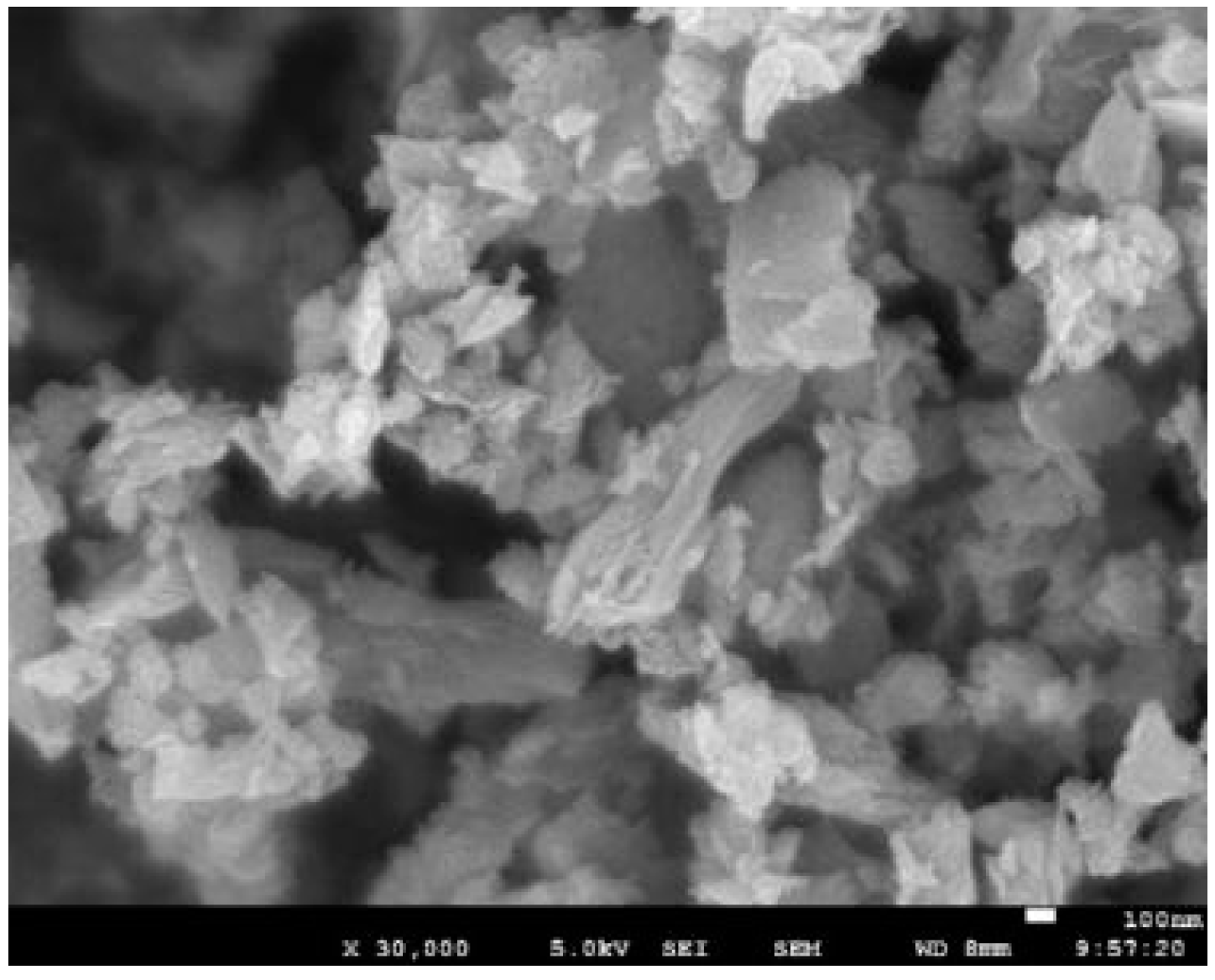
Figure 4.
SEM of N660 carbon black.
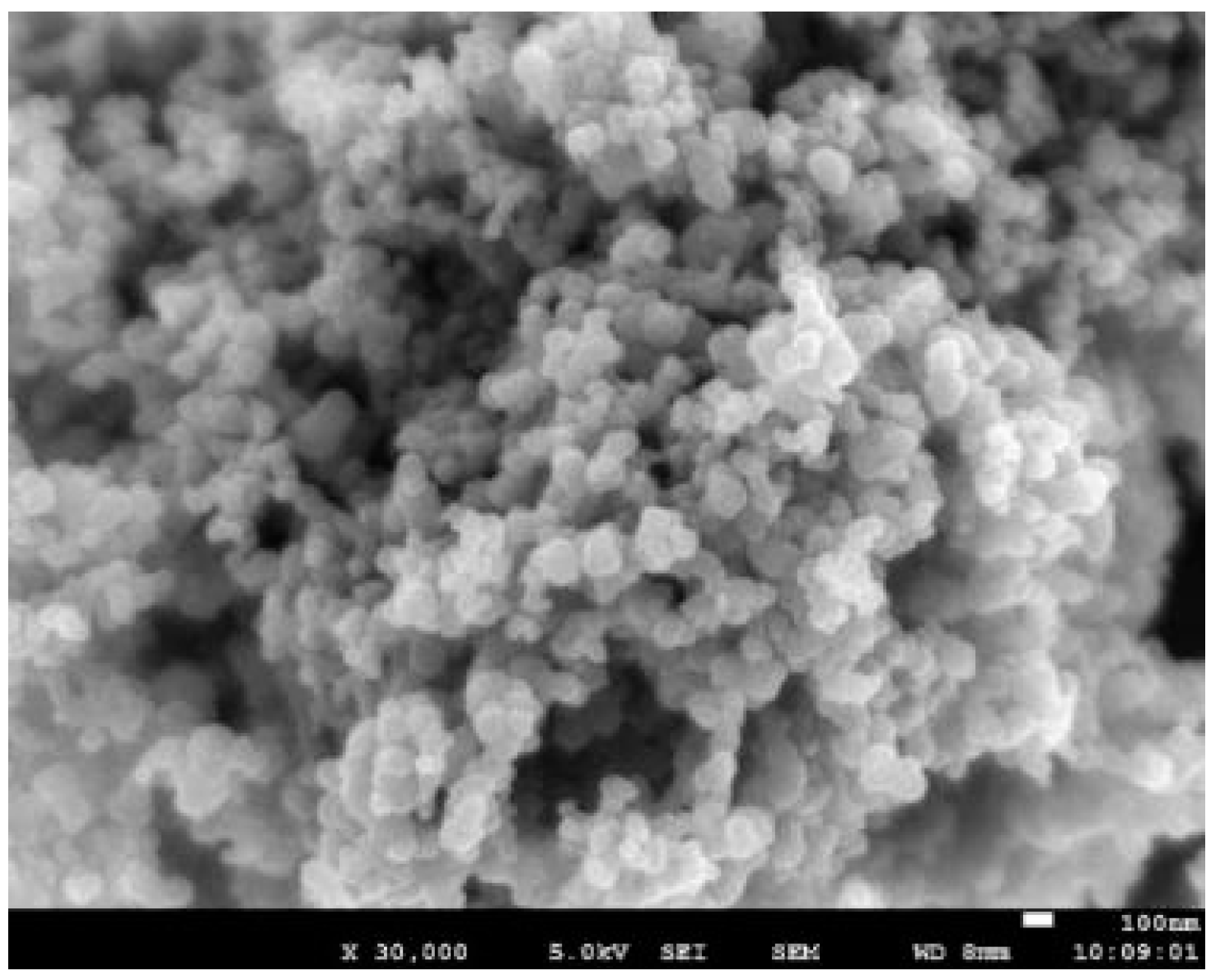
Figure 5.
Raman spectra of the carbon powder.
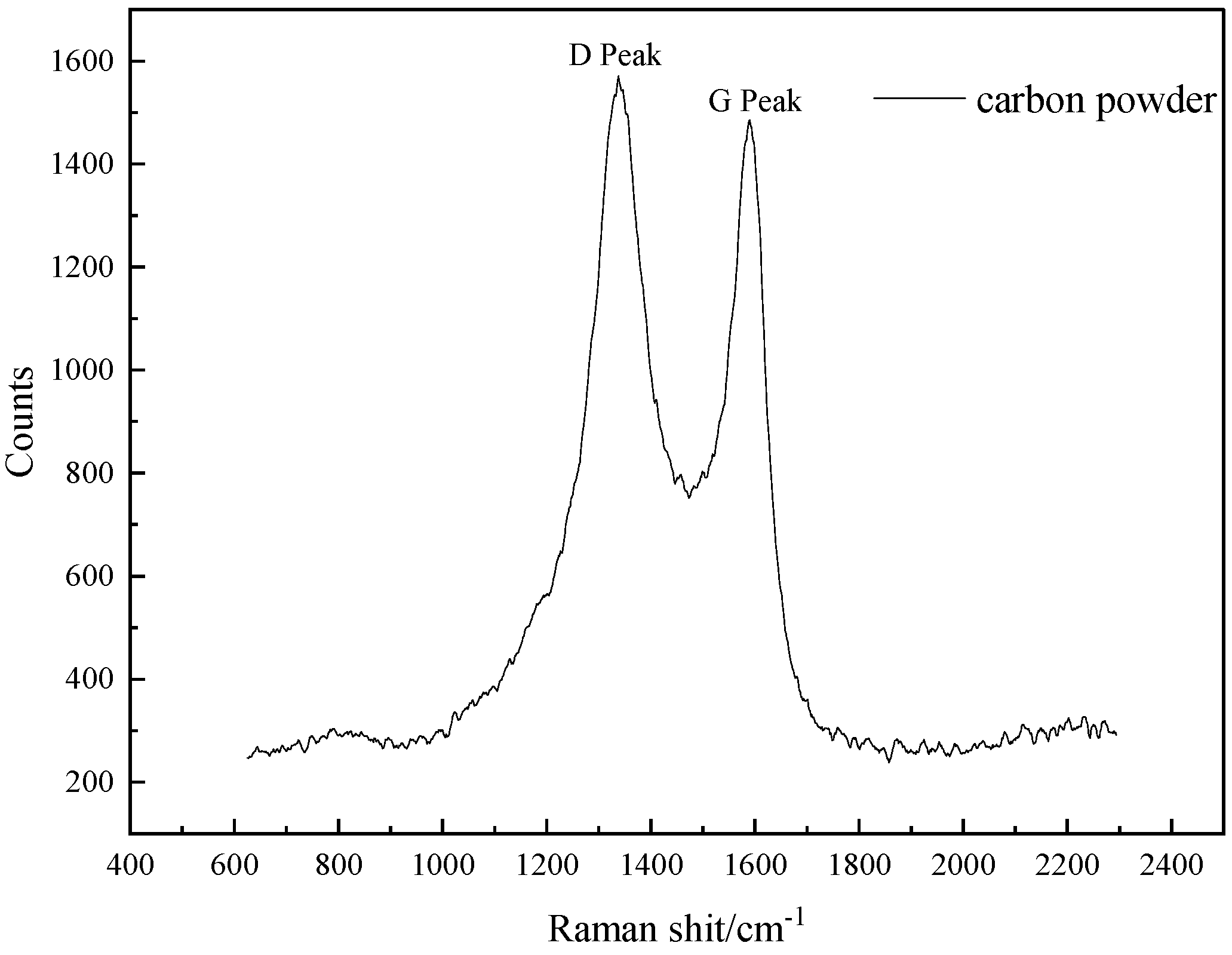
Figure 6.
Raman spectra of the N660 carbon black.
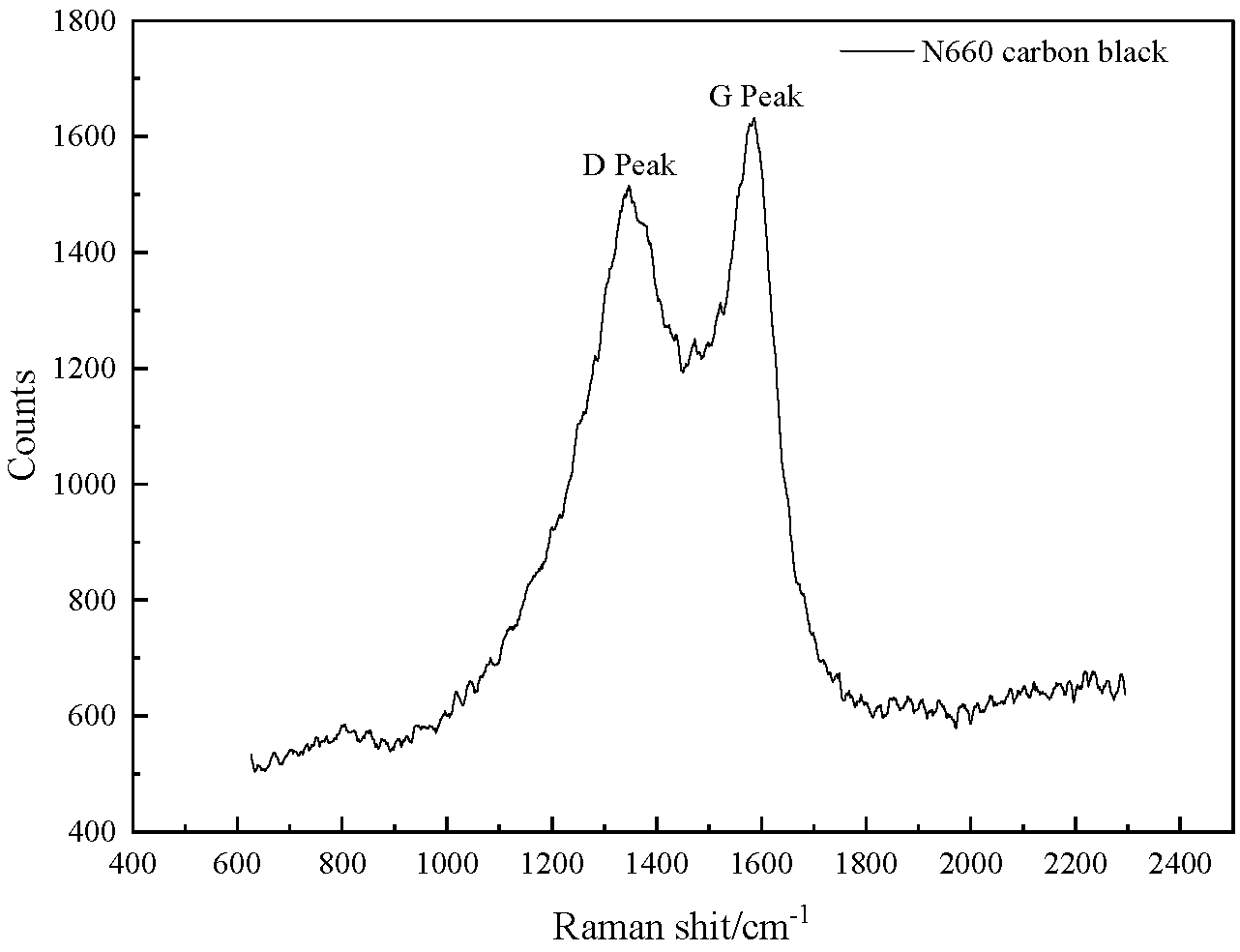
Figure 7.
SEM diagram of NBR composite section filled with 20 phr carbon powder.

Figure 8.
SEM diagram of the section of NBR composite filled with 40phr carbon powder.

Figure 9.
SEM diagram of NBR composite section filled with 20 phr N660 carbon black.

Figure 10.
SEM diagram of NBR composite section filled with 40 phr N660 carbon black.
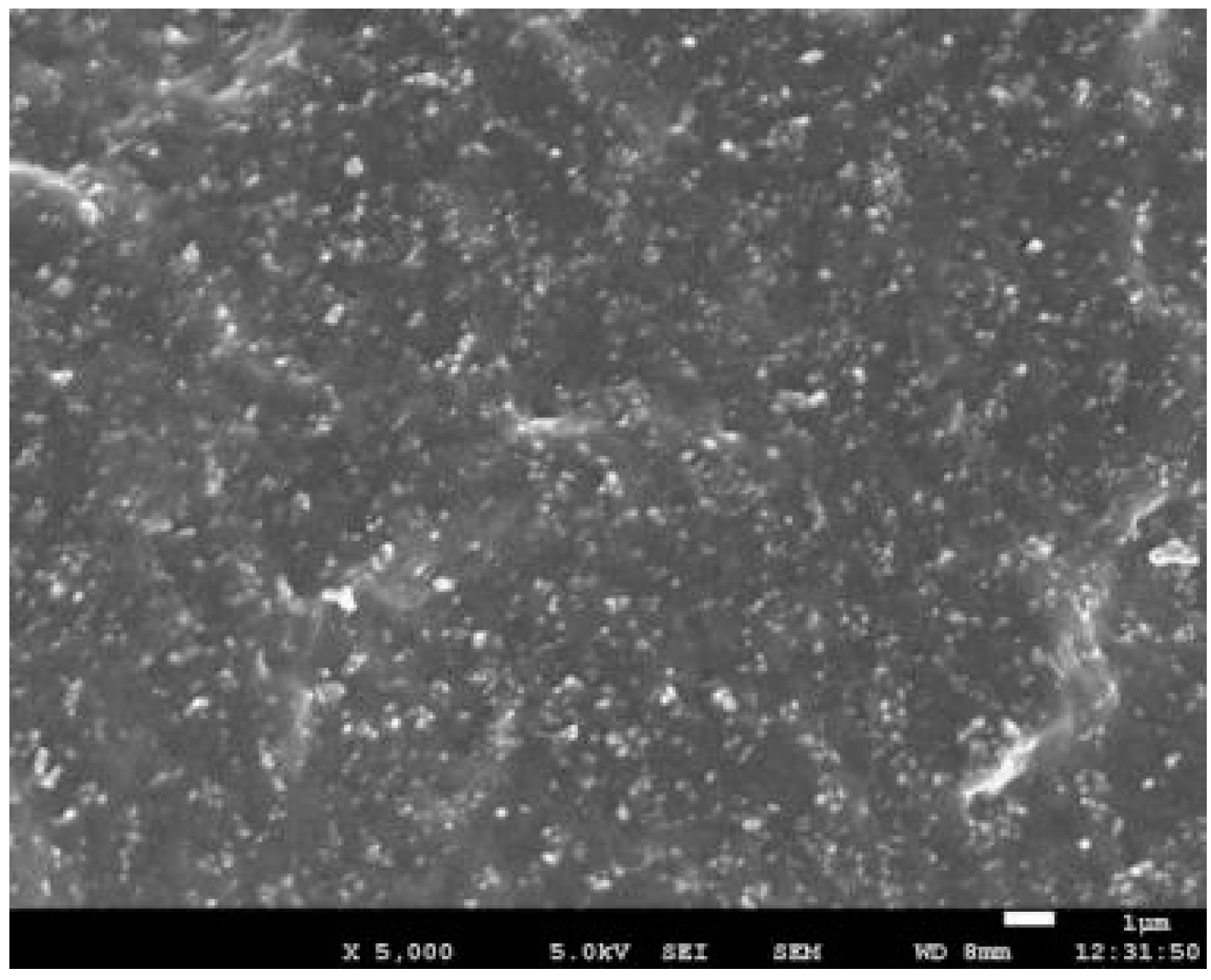
Figure 11.
SEM image of NBR composite section filled with 20 phr. N660 carbon black / 20 phr carbon powder.
Figure 11.
SEM image of NBR composite section filled with 20 phr. N660 carbon black / 20 phr carbon powder.

Figure 12.
A comparison chart of tensile strength of NBR filled with carbon black / carbon pow-der.
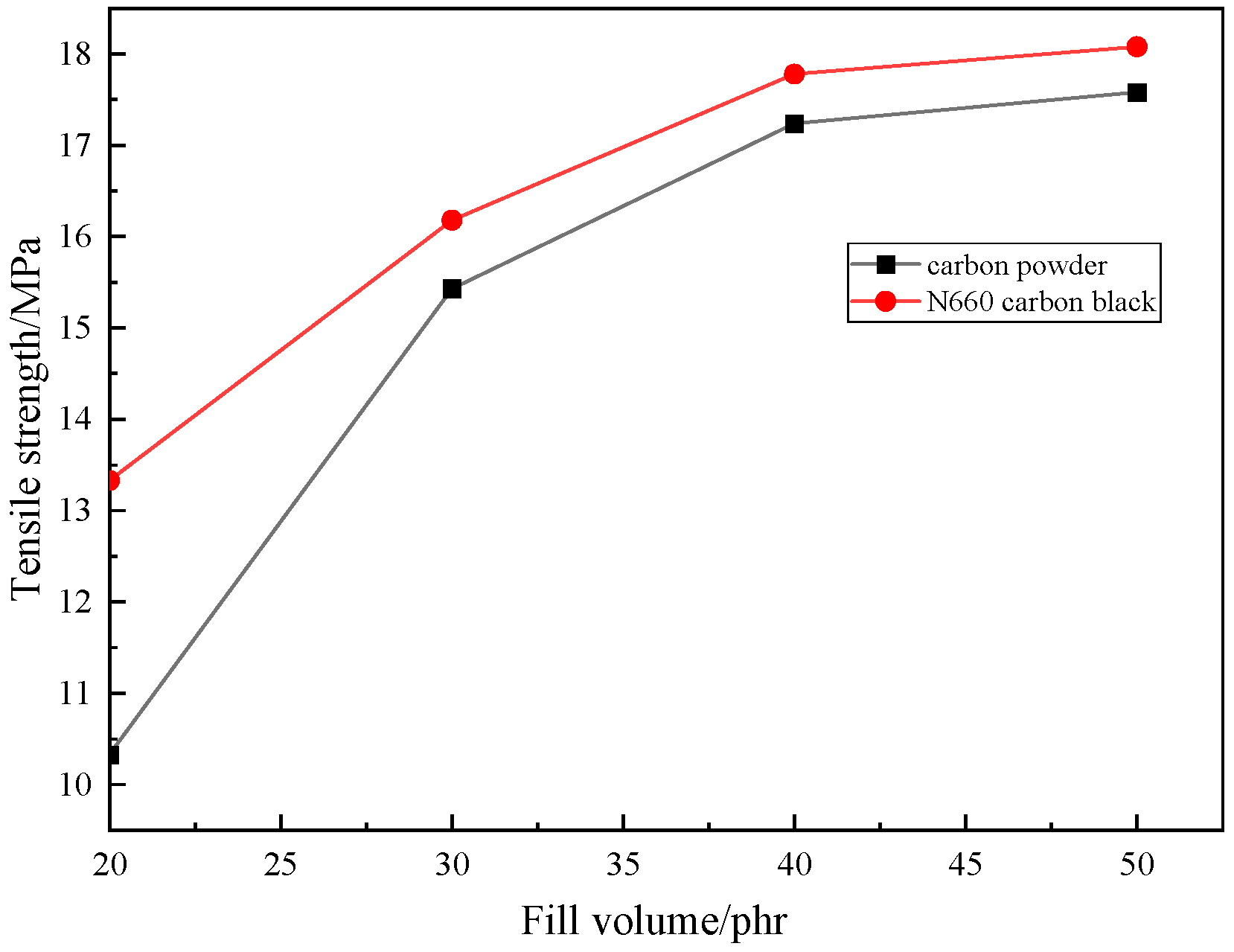
Figure 13.
A comparison chart of Pull-off elongation of NBR filled with carbon powder / carbon black.
Figure 13.
A comparison chart of Pull-off elongation of NBR filled with carbon powder / carbon black.

Figure 14.
A comparison chart of 300% constant strain stress of NBR filled with carbon powder / carbon black.
Figure 14.
A comparison chart of 300% constant strain stress of NBR filled with carbon powder / carbon black.

Figure 15.
A comparison chart of tear strength of NBR filled with carbon powder / carbon black.

Figure 16.
A comparison chart of hardness of NBR rubber filled with carbon powder / carbon black.

Figure 17.
The electrical conductivity of NBR filled with different quality fractions of carbon powder at different frequencies.
Figure 17.
The electrical conductivity of NBR filled with different quality fractions of carbon powder at different frequencies.

Figure 18.
The electrical conductivity of NBR filled with different quality fractions of carbon black at different frequencies.
Figure 18.
The electrical conductivity of NBR filled with different quality fractions of carbon black at different frequencies.

Figure 19.
Thermal conductivity of NBR filled 30 phr carbon powder / carbon black.

Figure 20.
Thermal conductivity of NBR filled 40 phr carbon powder / carbon black.

Figure 21.
Thermal conductivity of NBR filled 50 phr carbon powder / carbon black.

Disclaimer/Publisher’s Note: The statements, opinions and data contained in all publications are solely those of the individual author(s) and contributor(s) and not of MDPI and/or the editor(s). MDPI and/or the editor(s) disclaim responsibility for any injury to people or property resulting from any ideas, methods, instructions or products referred to in the content. |
© 2024 by the authors. Licensee MDPI, Basel, Switzerland. This article is an open access article distributed under the terms and conditions of the Creative Commons Attribution (CC BY) license (http://creativecommons.org/licenses/by/4.0/).
Copyright: This open access article is published under a Creative Commons CC BY 4.0 license, which permit the free download, distribution, and reuse, provided that the author and preprint are cited in any reuse.
MDPI Initiatives
Important Links
© 2024 MDPI (Basel, Switzerland) unless otherwise stated





